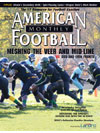AMERICAN FOOTBALL MONTHLY THE #1 RESOURCE FOR FOOTBALL COACHES
Article CategoriesAFM Magazine
|
Spin OffensePassing Game Adjustmentsby: Dale Weiner Head Coach, Catholic High School, Baton Rouge (LA) © More from this issue One of the great strengths of the Spin Offense is the excellent play action passing game that is available. Due to the fact that defenses must funnel quickly to the perimeter, they can be very vulnerable to a passing game that attacks the void left in the secondary by pursuing defenders. The mainstay of this passing attack is the Spin Pass. The basics of the Spin Pass have been presented in previous articles. However, here is a quick review. The Spin Pass is true play action. It comes off of our Spin Sweep. If the call is ‘Spin Pass Right,’ the left slot goes in fast motion toward the QB. He fakes taking the ball from the QB and then comes down hill quickly to protect the right edge. The QB pivots, as in the sweep, and then pulls up in the right B gap. The FB jab steps to the right and then comes across the format....The full article can only be seen by subscribers. Subscribe today!
|
|
|||||||
| HOME |
MAGAZINE |
SUBSCRIBE | ONLINE COLUMNISTS | COACHING VIDEOS |
Copyright 2025, AmericanFootballMonthly.com
All Rights Reserved





